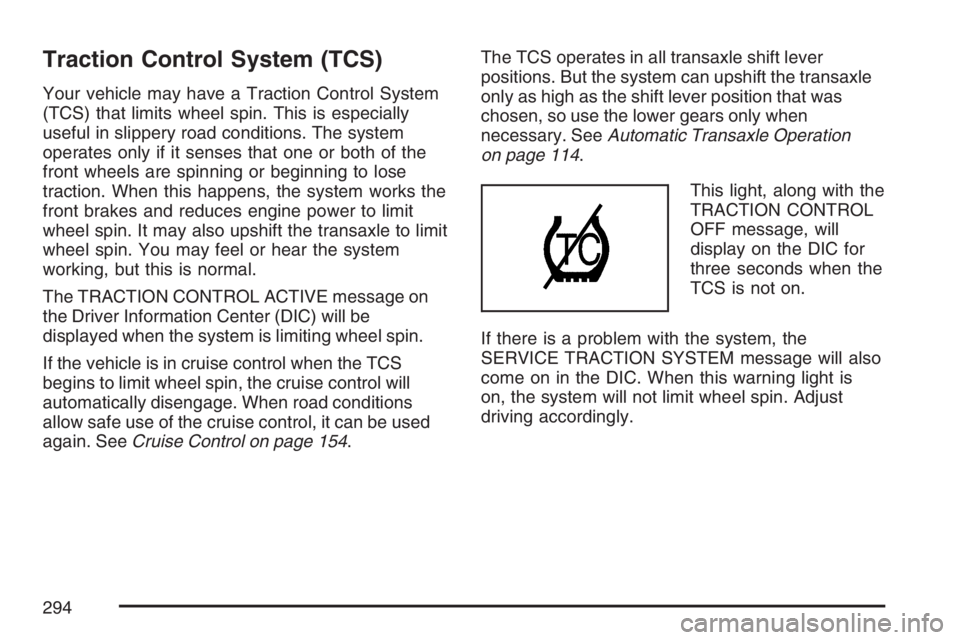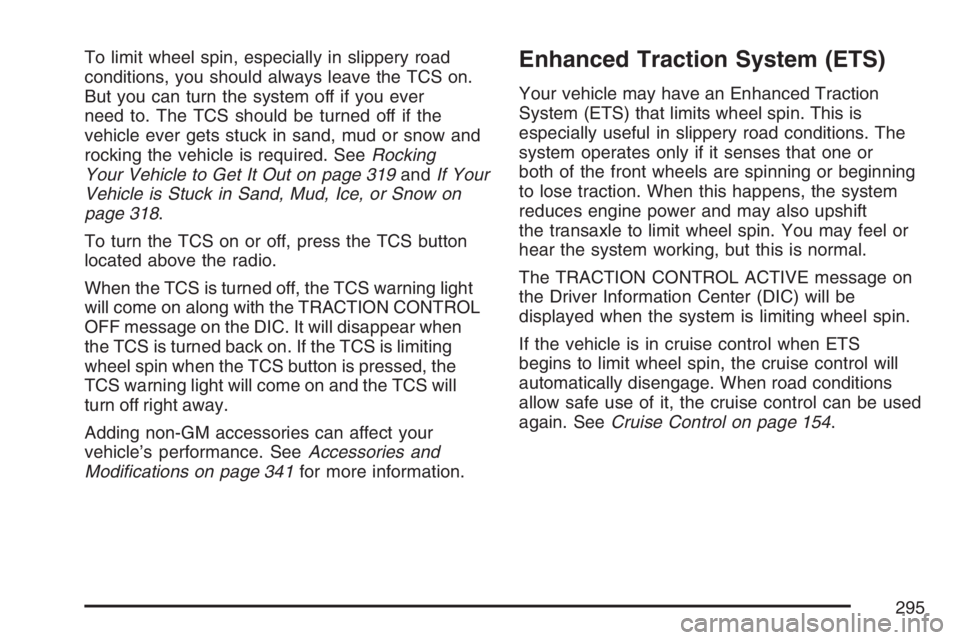2007 BUICK LACROSSE cruise control
[x] Cancel search: cruise controlPage 294 of 512

Traction Control System (TCS)
Your vehicle may have a Traction Control System
(TCS) that limits wheel spin. This is especially
useful in slippery road conditions. The system
operates only if it senses that one or both of the
front wheels are spinning or beginning to lose
traction. When this happens, the system works the
front brakes and reduces engine power to limit
wheel spin. It may also upshift the transaxle to limit
wheel spin. You may feel or hear the system
working, but this is normal.
The TRACTION CONTROL ACTIVE message on
the Driver Information Center (DIC) will be
displayed when the system is limiting wheel spin.
If the vehicle is in cruise control when the TCS
begins to limit wheel spin, the cruise control will
automatically disengage. When road conditions
allow safe use of the cruise control, it can be used
again. SeeCruise Control on page 154.The TCS operates in all transaxle shift lever
positions. But the system can upshift the transaxle
only as high as the shift lever position that was
chosen, so use the lower gears only when
necessary. SeeAutomatic Transaxle Operation
on page 114.
This light, along with the
TRACTION CONTROL
OFF message, will
display on the DIC for
three seconds when the
TCS is not on.
If there is a problem with the system, the
SERVICE TRACTION SYSTEM message will also
come on in the DIC. When this warning light is
on, the system will not limit wheel spin. Adjust
driving accordingly.
294
Page 295 of 512

To limit wheel spin, especially in slippery road
conditions, you should always leave the TCS on.
But you can turn the system off if you ever
need to. The TCS should be turned off if the
vehicle ever gets stuck in sand, mud or snow and
rocking the vehicle is required. SeeRocking
Your Vehicle to Get It Out on page 319andIf Your
Vehicle is Stuck in Sand, Mud, Ice, or Snow on
page 318.
To turn the TCS on or off, press the TCS button
located above the radio.
When the TCS is turned off, the TCS warning light
will come on along with the TRACTION CONTROL
OFF message on the DIC. It will disappear when
the TCS is turned back on. If the TCS is limiting
wheel spin when the TCS button is pressed, the
TCS warning light will come on and the TCS will
turn off right away.
Adding non-GM accessories can affect your
vehicle’s performance. SeeAccessories and
Modi�cations on page 341for more information.Enhanced Traction System (ETS)
Your vehicle may have an Enhanced Traction
System (ETS) that limits wheel spin. This is
especially useful in slippery road conditions. The
system operates only if it senses that one or
both of the front wheels are spinning or beginning
to lose traction. When this happens, the system
reduces engine power and may also upshift
the transaxle to limit wheel spin. You may feel or
hear the system working, but this is normal.
The TRACTION CONTROL ACTIVE message on
the Driver Information Center (DIC) will be
displayed when the system is limiting wheel spin.
If the vehicle is in cruise control when ETS
begins to limit wheel spin, the cruise control will
automatically disengage. When road conditions
allow safe use of it, the cruise control can be used
again. SeeCruise Control on page 154.
295
Page 297 of 512

When the system activates, a STABILITY
CONTROL ACTIVE message will be displayed on
the Driver Information Center (DIC). SeeDIC
Warnings and Messages on page 208. You may
also hear a noise or feel vibration in the brake
pedal. This is normal. Continue to steer the vehicle
in the direction you want it to go.
If there is a problem detected with StabiliTrak
®,a
SERVICE STABILITY SYSTEM or STABILITY
CONTROL OFF message will be displayed on the
Driver Information Center (DIC). A warning light
will also appear on the instrument panel cluster.
SeeDIC Warnings and Messages on page 208.
When this message is displayed, the system is not
operational. Driving should be adjusted
accordingly.
If your vehicle is in cruise control when the
StabiliTrak
®activates, the cruise control will
automatically disengage. When road conditions
allow you to safely use it again, you may reengage
the cruise control. SeeCruise Control on
page 154for more information.
Steering
Power Steering
If you lose power steering assist because the
engine stops or the system is not functioning, you
can steer but it will take much more effort.
Steering Tips
It is important to take curves at a reasonable
speed.
A lot of the “driver lost control” accidents mentioned
on the news happen on curves. Here is why:
Experienced driver or beginner, each of us is
subject to the same laws of physics when driving on
curves. The traction of the tires against the road
surface makes it possible for the vehicle to change
its path when you turn the front wheels. If there is
no traction, inertia will keep the vehicle going in the
same direction. If you have ever tried to steer a
vehicle on wet ice, you will understand this.
297
Page 451 of 512

Fuses Usage
DR/LCK
TRUNKDoor Locks, Trunk
RFA/MOD Remote Keyless Entry
PRK/SWTCH Ignition Key Lock
CLSTR Cluster
STR/WHL/
ILLUMSteering Wheel Controls
Illumination
ONSTAR/ALDL OnStar
®, Data Link
Fuses Usage
INT/ILLUM Interior Lamps
PWR/SEAT Power Seat
S/ROOF Sunroof
CNSTR Canister Vent
HVAC Climate Control System
HAZRD Turn Signal, Hazard
PRK/LAMP Park Lamps
CHMSL/BKUPCenter-High-Mounted
Stoplamp/Back-up Lamps
PWR/MIR Power Mirrors
CRUISE Cruise Control
RDO/AMP Radio, Ampli�er
HTD/SEAT Heated Seats
HTD/MIR Heated Mirrors
PWR/WNDW Power Window
Relays Usage
RAP Retained Accessory Power
PRK/LAMP Park Lamp Relay
R/DEFOG Rear Defogger Relay
451
Page 466 of 512

(h)Change automatic transaxle �uid and �lter if
the vehicle is mainly driven under one or more of
these conditions:
�In heavy city traffic where the outside
temperature regularly reaches 90°F (32°C)
or higher.
�In hilly or mountainous terrain.
�When doing frequent trailer towing.
�Uses such as found in taxi, police, or
delivery service.
(i)Drain, �ush, and re�ll cooling system. This
service can be complex; you should have
your dealer perform this service. See Engine
Coolant on page 363 for what to use. Inspect
hoses. Clean radiator, condenser, pressure cap,
and �ller neck. Pressure test the cooling
system and pressure cap.
(j)Check throttle system for interference or
binding and for damaged or missing parts. Replace
parts as needed. Replace any components that
have high effort or excessive wear. Do not
lubricate accelerator or cruise control cables.(k)A �uid loss in any vehicle system could
indicate a problem. Have the system inspected
and repaired and the �uid level checked. Add �uid
if needed.
(l)If you drive regularly under dusty conditions,
inspect the �lter at each engine oil change.
(m)Visually inspect belt for fraying, excessive
cracks, or obvious damage. Replace belt if
necessary.
Owner Checks and Services
These owner checks and services should be
performed at the intervals speci�ed to help
ensure the safety, dependability, and emission
control performance of your vehicle. Your
GM Goodwrench
®dealer can assist you with
these checks and services.
Be sure any necessary repairs are completed at
once. Whenever any �uids or lubricants are added
to your vehicle, make sure they are the proper
ones, as shown inRecommended Fluids and
Lubricants on page 470.
466
Page 500 of 512

Cleaning (cont.)
Underbody Maintenance........................... 446
Washing Your Vehicle.............................. 442
Weatherstrips........................................... 442
Windshield and Wiper Blades................... 444
Climate Control System............................... 168
Air Filter, Passenger Compartment........... 178
Dual Automatic......................................... 172
Outlet Adjustment..................................... 177
Collision Damage Repair............................. 490
Comfort Guides, Rear Safety Belt................. 35
Compact Spare Tire.................................... 437
Compass..................................................... 206
Content Theft-Deterrent............................... 104
Control of a Vehicle..................................... 290
Convenience Net......................................... 142
Coolant
Engine Temperature Gage........................ 189
Engine Temperature Warning Light........... 188
Heater, Engine......................................... 112
Low Warning Light................................... 189
Cooling System........................................... 370
Courtesy Lamps.......................................... 161
Cruise Control............................................. 154
Cruise Control Light.................................... 195
Cupholder(s)................................................ 141Customer Assistance Information
Courtesy Transportation........................... 487
Customer Assistance for Text Telephone
(TTY) Users.......................................... 482
Customer Assistance Offices.................... 482
Customer Satisfaction Procedure.............. 478
GM Mobility Reimbursement Program...... 483
Reporting Safety Defects to
General Motors..................................... 495
Reporting Safety Defects to the
Canadian Government.......................... 494
Reporting Safety Defects to the
United States Government.................... 494
Roadside Assistance Program.................. 484
Service Publications Ordering
Information........................................... 495
D
Daytime Running Lamps/Automatic
Headlamp System.................................... 159
Defensive Driving........................................ 286
Delayed Entry Lighting................................ 162
Delayed Exit Lighting................................... 162
Delayed Locking............................................ 97
DIC Compass.............................................. 206
Disc, MP3................................................... 272
500
Page 504 of 512

I
Ignition Positions......................................... 109
Infants and Young Children, Restraints.......... 42
In�ation - Tire Pressure............................... 409
Instrument Panel
Overview.................................................. 148
Instrument Panel (I/P)
Brightness................................................ 161
Cluster..................................................... 180
Interior Lamps............................................. 161
J
Jump Starting.............................................. 385
K
Keyless Entry System................................... 89
Keys............................................................. 87
L
Labeling, Tire Sidewall................................. 403
Lamps
Battery Run-Down Protection................... 164
Courtesy.................................................. 161
Electric Power Management..................... 163
Exterior.................................................... 158
Exterior Lighting Battery Saver................. 160
Fog .......................................................... 160
Interior..................................................... 161
Overhead Console Reading..................... 163
Rear Assist Handle Reading.................... 163
LATCH System
Child Restraints......................................... 51
License Plate Lamps................................... 400
Light
Airbag Readiness..................................... 182
Anti-Lock Brake System Warning............. 187
Brake System Warning............................. 186
Change Engine Oil................................... 195
Charging System..................................... 185
Check Gas Cap....................................... 199
Cruise Control.......................................... 195
504